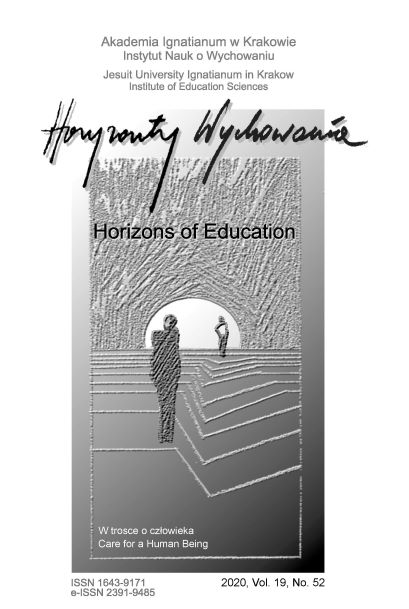Loneliness in young people as perceived by students
Abstract
RESEARCH OBJECTIVE: The aim of this paper is to recognise students' views on the phenomenon of loneliness among young people.
THE RESEARCH PROBLEM AND METHODS: The problem addressed in the text is contained in the question What are the views on loneliness in young people held by the surveyed students? The diagnostic survey method (the questionnaire technique), as well as an analysis and synthesis of the literature on the subject, were usedThe first part of the .
THE PROCESS OF ARGUMENTATION: This paper presents theoretical considerations on the problem of loneliness, while the second part analyses the opinions of the surveyed students concerning, among other things, their understanding of loneliness, the reasons for this problem, and ways of dealing with loneliness.
RESEARCH RESULTS: Loneliness is most often perceived as an unpleasant condition, an oppressive state of emptiness, negatively affecting human life. The development of new technologies, dysfunctions in the family environment and specific personality dispositions in the individual, were identified as the causes of loneliness among young people. Among the possibilities for coping with loneliness, the respondents indicated ways beneficial for both individual and social development and unfavourable ones.
CONCLUSSIONS, INNOVATIONS, RECOMMENDATIONS: The research shows that the loneliness experienced by young people is becoming the norm today, and requires them to take up special stratagems aimed at filling the void. Therefore, it is necessary to take responsible actions to prevent young people’s being “lonely in a crowd”. It is important to make parents aware of the importance of their genuine presence with their offspring, to show support for their children, and to build a proper bond. The influence and attitudes of teachers are important in counteracting the loneliness of young people.
References
Booth, R. (1996). The importance of understanding loneliness. Perspectives: A Mental Health Journal, 1, 4, 1-7.
Chałas, K. (2003a). Samotność a osiągnięcia edukacyjne wychowanka. W: A. Karpińska (red.). U podstaw dialogu o edukacji. Białystok: Trans Humana,181-196.
Chałas, K. (2003b). Samotność dziecka i jej aspekty pedagogiczne. W: J. Kuźmy i J. Morbitzera (red.). Nauki pedagogiczne w teorii i praktyce edukacyjnej, tom I, Kraków: Wyd. Naukowe Akademii Pedagogicznej, 111-120.
Chałas,K. (2005). Samotność siłą kreacji osobowej wychowanka. W: E. A. Zwolińska (red.). Edukacja kreatywna. Bydgoszcz: Wyd. AB.
Dołęga, Z. (1997). Rozumienie samotności przez dzieci i młodzież, „Psychologia Wychowawcza”, nr 5.
Dołęga, Z. (2003). Samotność młodzieży - analiza teoretyczna i studia empiryczne. Katowice: Wydawnictwo Uniwersytetu Śląskiego.
Dołęga, Z. (2006). Poczucie samotności wśród uczniów w kontekście spójności klasy szkolnej. W: M. John - Borys, Z. Dołęga (red.). Z badań nad zdrowiem psychicznym uczniów - wstęp do działań profilaktycznych szkoły. Katowice: Wyd. Uniwersytetu Śląskiego.
Dubas, E. (2000). Edukacja dorosłych w sytuacji samotności i osamotnienia. Łódź: Wydawnictwo Uniwersytetu Łódzkiego.
Dubas, E. (2006). Samotność – uniwersalny „temat” życia i wychowania. W: P. Domeracki, W., Tyburski, P. (2006) (red.). Zrozumieć samotność. Studium interdyscyplinarne. Toruń: Wydawnictwo Uniwersytetu Mikołaja Kopernika.
Ernst, J. M., Cacioppo, J. T. (1999). Lonely hearts: Psychological perspective on loneliness. Applied and Preventive Psychology, 8, 1-22.
Erozkan, A. (2011). The attachment styles bases of loneliness and depression. International Journal of Psychology and Counseling, 3, 9, 186-193.
Jakubowska, L. (2004). Współczesne oblicza samotności wśród młodzieży. Kultura i Edukacja, 4.
Jakuta, M. (2012). Zagubieni w tłumie – poczucie osamotnienia u współczesnej młodzieży. Resocjalizacja Polska, 3, 399-410.
Kozłowski W.: Samotność i osamotnienie, „ Nowa Szkoła”,1996, nr 5.
Lake, T. (1993). Samotność. Jak sobie z nią radzić, Warszawa: Wydawnictwo Książka i Wiedza.
Łopatkowa, M. (1983). Samotność dziecka, Warszawa: WSiP.
Pawłowska, R. Jundziłł, E. (2006). Pedagogika człowieka samotnego, Gdańsk: Gdańska Wyższa Szkoła Humanistyczna.
Rembowski, J. (1992). Samotność. Gdańsk: Wydawnictwo Uniwersytetu Gdańskiego.
Rębisz, S. Sikora, I. Smoleń – Rębisz, K. (2016). Poczucie samotności a poziom uzależnienia od internetu wśród adolescentów. Edukacja - Technika - Informatyka, 1(15), 90-98.
Ruszkiewicz, D. (2008). Życie w pojedynkę - ucieczka od rodziny czy znak naszych czasów?. Łódź: Wyd. Wyższej Szkoły Humanistyczno-Ekonomicznej.
Twardowska - Rajewska, J. (2005). Przeciw samotności, Poznań: Wydawnictwo Naukowe UAM.
Victor, C., Scambler, S., Bond, J., & Bowling, A. (2000). Being alone in later life: Loneliness, social isolation and living alone. Reviews in Clinical Gerontology, 10(4), 407–417.
Wasilewska, K. M. (2010). Samotność młodzieży. Bydgoszcz: Wydawnictwo Kujawsko- Pomorskie Szkoły Wyższej.
Wasilewska – Ostrowska, K. (2013). Samotność emocjonalna - jako jeden z czynników ryzyka uzależnień wśród młodzieży. Wychowanie na co Dzień, 10-11, 17-21.
ŹRÓDŁA INTERNETOWE:
Dołęga, Z. (2019). Paradoksy samotności psychologicznej https://www.youtube.com/watch?v=mjBA6nRy-SY Pobrano: 27/01/2020 13:41:20
Copyright (c) 2020 Joanna Wrótniak

This work is licensed under a Creative Commons Attribution-NoDerivatives 4.0 International License.
Authors who publish in this journal agree to the following terms:
- Authors retain the copyright to their work while granting the journal the right of first publication. The work will be simultaneously licensed under a CC BY-ND license, which permits others to share the work with proper credit given to the author and the original publication in this journal.
- Authors may enter into additional, non-exclusive agreements for the distribution of the published version of the work (e.g., posting it in an institutional repository or publishing it in another journal), provided that the original publication in this journal is acknowledged.
We allow and encourage authors to share their work online (e.g., in institutional repositories or on personal websites) both before and during the submission process, as this can foster beneficial exchanges and lead to earlier and increased citations of the published work. (See The Effect of Open Access). We recommend using any of the following academic networking platforms:





